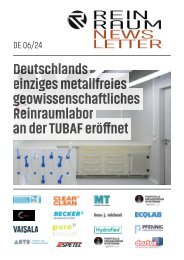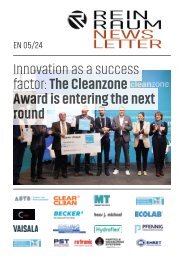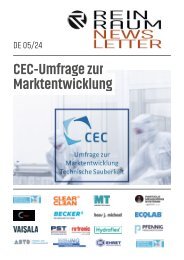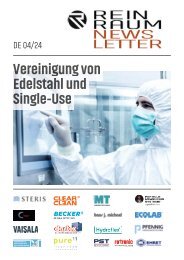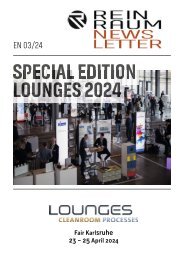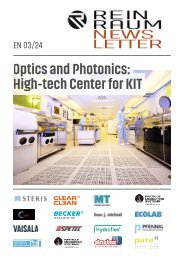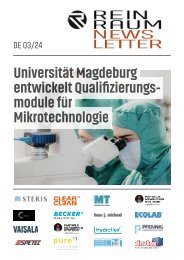Newsletter_12-2022_EN
Fachbeiträge, redaktionelle Beiträge und Veranstaltungen In einer sich schnell entwickelnden Branche sind aktuelle Informationen wichtig. reinraum online bietet einerseits Interessierten die Möglichkeit, sich aktuell und umfassend über die Reinraum-Branche zu informieren. Andererseits können Unternehmen und Personen die Plattform nutzen, Fachbeiträge, redaktionelle Artikel und Firmennews zu veröffentlichen. Ein Veranstaltungskalender ergänzt das Informationsangebot. Der ExpertenPool hilft bei der Profi-Suche: WER macht WAS im Reinraum.
Fachbeiträge, redaktionelle Beiträge und Veranstaltungen
In einer sich schnell entwickelnden Branche sind aktuelle Informationen wichtig. reinraum online bietet einerseits Interessierten die Möglichkeit, sich aktuell und umfassend über die Reinraum-Branche zu informieren. Andererseits können Unternehmen und Personen die Plattform nutzen, Fachbeiträge, redaktionelle Artikel und Firmennews zu veröffentlichen. Ein Veranstaltungskalender ergänzt das Informationsangebot.
Der ExpertenPool hilft bei der Profi-Suche: WER macht WAS im Reinraum.
You also want an ePaper? Increase the reach of your titles
YUMPU automatically turns print PDFs into web optimized ePapers that Google loves.
www.reinraum.de<br />
NEWSLETTER<br />
www.cleanroom-online.com Edition <strong>EN</strong> <strong>12</strong>-<strong>2022</strong> | Page 4/42<br />
On the subject of wet loads, this is the most worrying factor. When<br />
steam enters the autoclave chamber and contacts with the product, it<br />
is important that the steam collapses (condenses) on the product. This<br />
is in order for the heat to be released to the load. However, the formation<br />
of water must be discharged through condensate management<br />
or re-vaporized in order to prevent contamination of the product. Removal<br />
of the excess water is important to prevent insulation of the<br />
load from the steam.<br />
We also need to be mindful of pressure and its relationship to<br />
temperature. Given that autoclaves destroy microorganisms by direct<br />
steam contact at the required temperature and pressure for a specified<br />
time, pressure control is important. Poor pressure control can<br />
cause variations in steam velocities.<br />
Critical issues in autoclave sterilization<br />
What are the main critical issues in autoclave sterilization processes?<br />
Some of the key issues are based on the failure modes. Understanding<br />
these modes is important for controlling the critical issues. One that<br />
stands out is load design. Many companies will use a matrix approach,<br />
whereby worst case load configurations are validated with a view to<br />
allowing other load combinations to be used without undergoing<br />
validation. Here care must be taken with the design of the matrix so<br />
that anything relating to the load that can affect the distribution of<br />
the incoming steam or which can affect uniformity of temperature is<br />
identified and accounted for. The assessment should also take into account<br />
anything that can take heat away from the chamber can affect<br />
temperature uniformity.<br />
Often mass is used for the matrix. However, there are other factors<br />
that can affect sterilization. These include the shape of the equipment,<br />
where narrow pipework or hoses presents a particular challenge in<br />
terms of steam penetration (here center of the length of hose is the<br />
most difficult to sterilize); whereas with worst-case location within a<br />
bottle, flask or cylinder the worst case is the center near the bottom<br />
of the container.<br />
The orientation of the equipment is also important, and this affects<br />
whether the item is capable of free-draining. Where there is uncertainty<br />
about what constitutes worst case some initial work can be<br />
undertaken thermometrically (heat penetration evaluation tests); this<br />
allows data to be collected about heat distribution, and this ‘hard to<br />
heat’ study is generally recommended. Account should be taken, with<br />
liquid loads, oft the viscosity of the liquid since this can affect heat<br />
penetration.<br />
A further factor is the type of material, such as elastomeric materials<br />
and stainless steel. If these types of materials are used in combination,<br />
then a balance of both may be needed for the worst case. However, if<br />
in practice the materials are sterilized separately, this may prompt two<br />
types of worst case loads.<br />
Materials: risks of medical paper and Tyvek® advantages<br />
Let’s talk about materials: despite the strong presence of cellulose,<br />
many continue to use medical paper. What are the risks and how,<br />
with the new Annex 1 is it necessary to deal with them?<br />
Packaging materials, used to wrap the items to be sterilized, are<br />
probably one of the most important parts of the sterilization process.<br />
Packaging provides a protective barrier for the sterile item and prevents<br />
it from becoming re-contaminated. When used in aseptic processing,<br />
the packaging should be of low particle generation.<br />
Cellulosic paper is not suitable for higher grade cleanrooms, especially<br />
due to the potential for fibers to be released. Annex 1 emphasizes<br />
that products need to be free of visible particulates. Non-autoclaved<br />
cellulosic paper is also probe to microbial contamination, given<br />
the range of microbes that are capable of cellulose hydrolysis.<br />
An alternative is Tyvek® and Tyvek®/PET-PP. Tyvek® material is<br />
made of continuous strong fibers of pure high-density polyethylene,<br />
is low linting and free of inherent contaminants that could represent<br />
a risk in critical environments. Tyvek® retains its dimensional stability<br />
and integrity and maintains its tensile strength, microbial barrier and<br />
the required air permeability to enable effective sterilization.<br />
In making the correct choice, packaging needs to be well designed<br />
and of sufficient porosity so that steam can pass through packaging.<br />
In addition, packaging should be water repellent to provide a<br />
sterile “field.” Furthermore, the packaging material must not change<br />
significantly during sterilization or release any substances that might<br />
interfere with the action of the steam.<br />
Autoclave load validation processes<br />
New Annex 1 requirements will force pharmaceutical manufacturers<br />
to revise their autoclave load validation processes.<br />
Validation needs to be designed carefully to avoid failures (or failures<br />
with re-validation). The Annex expects a greater level of detail<br />
and investigation. Failure to inactivate biological indicators is normally<br />
due to inadequate air removal rather than inadequate conditions of









